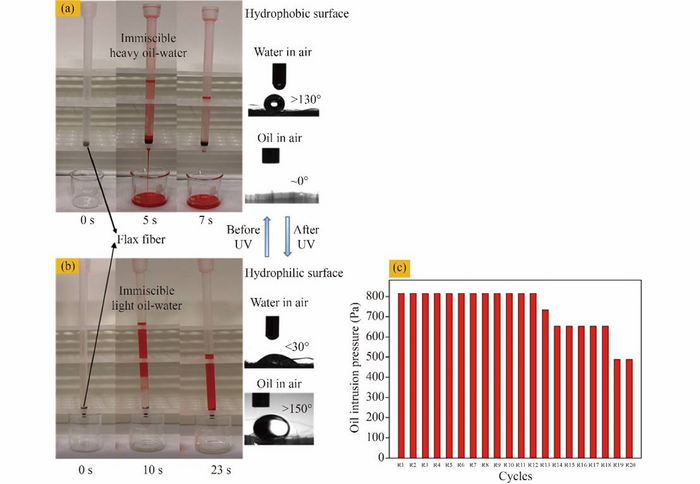The large number of oily wastewater discharges and oil spills are bringing about severe threats to environment and human health. Corresponding to this challenge, a number of functional materials have been developed and applied in oil-water separation as oil barriers or oil sorbents. These materials can be divided into two main categories which are artificial and natural.

Credit: Chen Xiujuan,Liu Yunqiu,Huang Gordon,An Chunjiang,Feng Renfei,Yao Yao,Huang Wendy,Weng Shuqing
The large number of oily wastewater discharges and oil spills are bringing about severe threats to environment and human health. Corresponding to this challenge, a number of functional materials have been developed and applied in oil-water separation as oil barriers or oil sorbents. These materials can be divided into two main categories which are artificial and natural.
Natural materials such as green bio-materials are generally low cost and abundant with biological degradability, which are also regarded as promising alternatives for oil-water separation and have been paid increasing attention. Many kinds of biomass materials, such as cotton fabrics, plant fibers, and kapoks, had been used for oil-water separation. To further improve the oil-water separation performances of biomass materials, many of them were artificially coated a functional layer with special wettability on their surfaces. However, these modified flax fibers merely have either hydrophobic or hydrophilic property, without the ability of switching between each other (or switchable wettability). Such a limitation may hinder their practical applications in oil-water separation. Functional flax fibers with switchable surface wettability are thus desired.
In this study, the researchers from University of Calgary, University of Regina, Concordia University, Canadian Light Source and McElhanney Inc. aimed to develop a functional flax fiber with switchable wettability for multipurpose oil-water separation. The flax fiber was coated with ZnO-hexadecyltrimethoxysilane (HDTMS) nanocomposites through a plasma-grafted poly (acrylic acid) (PAA) layer which acted as the binding agent. The as-prepared PAA-ZnO-HDTMS flax fiber was hydrophobic initially and could be switched to hydrophilic through UV irradiation. Its hydrophobicity could be easily recovered through being stored in dark environment for several days without UV irradiation. This study entitled “Functional flax fiber with UV-induced switchable wettability for multipurpose oil-water separation” is published online in Frontiers of Environmental Science & Engineering in 2022.
To optimize the performance of the PAA-ZnO-HDTMS flax fiber, the effects of ZnO and HDTMS concentrations on its switchable wettability were investigated. The developed PAA-ZnO-HDTMS flax fiber was comprehensively characterized through contact-angle measurement, SEM imaging, and synchrotron-based FTIR and X-ray analyses. The optimized PAA-ZnO-HDTMS flax fiber had a large water contact angle (~130°) in air and an extremely small oil contact angle (~0°) underwater initially. After UV treatment, the water contact angle was decreased to 30°, while the underwater oil contact angle was increased to more than 150°.
The mechanism of the acquired UV-induced switchable wettability was investigated. It could be concluded that the ZnO-HDTMS nanocomposites immobilized to the flax fiber surface endowed the UV-induced switchable wettability to the asprepared PAA-ZnO-HDTMS flax fiber. During the modification process, the silanol groups of HDTMS bonded with hydroxyl groups on the surfaces of flax fiber and ZnO NPs. Thus, the alkyl groups of HDTMS exposed on the surface of the fresh PAA-ZnO-HDTMS flax fiber, thus the flax fiber exhibited hydrophobic property. Nano-ZnO as a photo-responsive semiconducting material, electronhole pairs could be generated on its surface during UV irradiation. These holes could interact with the lattice oxygen of nano-ZnO to produce oxygen vacancies, which could then adsorb the surrounding water in the atmosphere to generate hydroxyl groups. These hydroxyl groups changed the surface property of modified flax fiber from hydrophobicity to hydrophilicity. When the PAA-ZnOHDTMS flax fibers were stored in a dark environment, ambient oxygen could replace the hydroxyl groups, reconverting the flax fiber surface from hydrophilic to hydrophobic.
Based on this UV-induced switchable wettability, the developed PAA-ZnO-HDTMS flax fiber was applied to remove oil from immiscible oil-water mixtures and oil-in-water emulsion with great reusability for multiple cycles. Thus, the developed flax fiber could be further fabricated into oil barrier or oil sorbent for oil-water separation, which could be an environmentally-friendly alternative in oil spill response and oily wastewater treatment.
###
About Higher Education Press
Founded in May 1954, Higher Education Press Limited Company (HEP), affiliated with the Ministry of Education, is one of the earliest institutions committed to educational publishing after the establishment of P. R. China in 1949. After striving for six decades, HEP has developed into a major comprehensive publisher, with products in various forms and at different levels. Both for import and export, HEP has been striving to fill in the gap of domestic and foreign markets and meet the demand of global customers by collaborating with more than 200 partners throughout the world and selling products and services in 32 languages globally. Now, HEP ranks among China’s top publishers in terms of copyright export volume and the world’s top 50 largest publishing enterprises in terms of comprehensive strength.
The Frontiers Journals series published by HEP includes 28 English academic journals, covering the largest academic fields in China at present. Among the series, 13 have been indexed by SCI, 6 by EI, 2 by MEDLINE, 1 by A&HCI. HEP’s academic monographs have won about 300 different kinds of publishing funds and awards both at home and abroad.
About Frontiers of Environmental Science & Engineering
Frontiers of Environmental Science & Engineering (FESE) is the leading edge forum for peer-reviewed original submissions in English on all main branches of environmental disciplines. FESE welcomes original research papers, review articles, short communications, and views & comments. All the papers will be published within 6 months since they are submitted. The Editors-in-Chief are Prof. Jiuhui Qu from Tsinghua University, and Prof. John C. Crittenden from Georgia Institute of Technology, USA. The journal has been indexed by almost all the authoritative databases such as SCI, Ei, INSPEC, SCOPUS, CSCD, etc.
Journal
Frontiers of Environmental Science & Engineering
DOI
10.1007/s11783-022-1588-6
Method of Research
Experimental study
Subject of Research
Not applicable
Article Title
Functional flax fiber with UV-induced switchable wettability for multipurpose oil-water separation
Article Publication Date
15-Dec-2022




